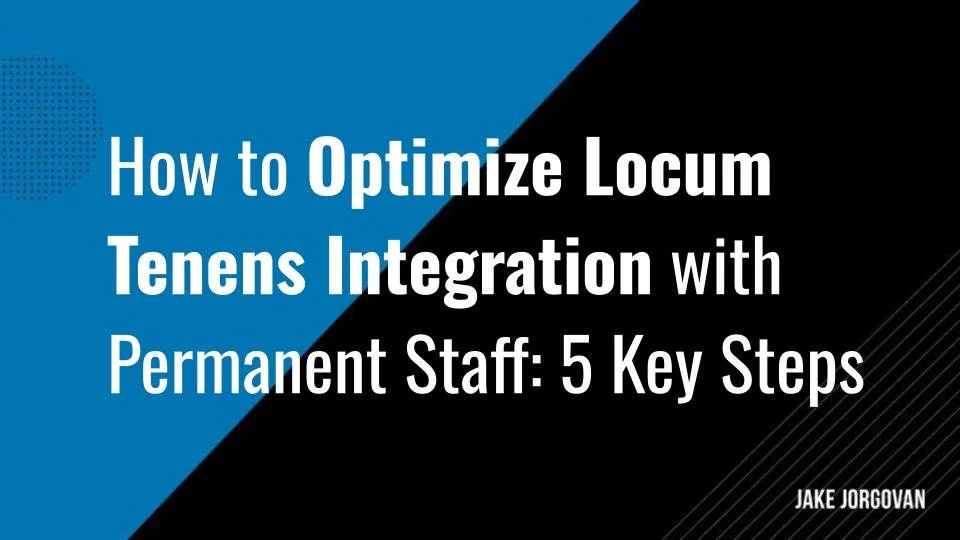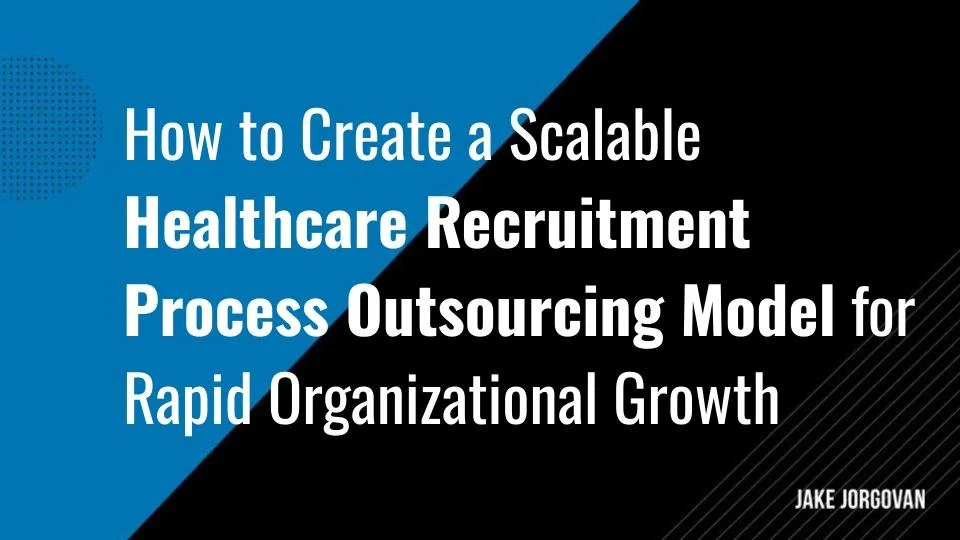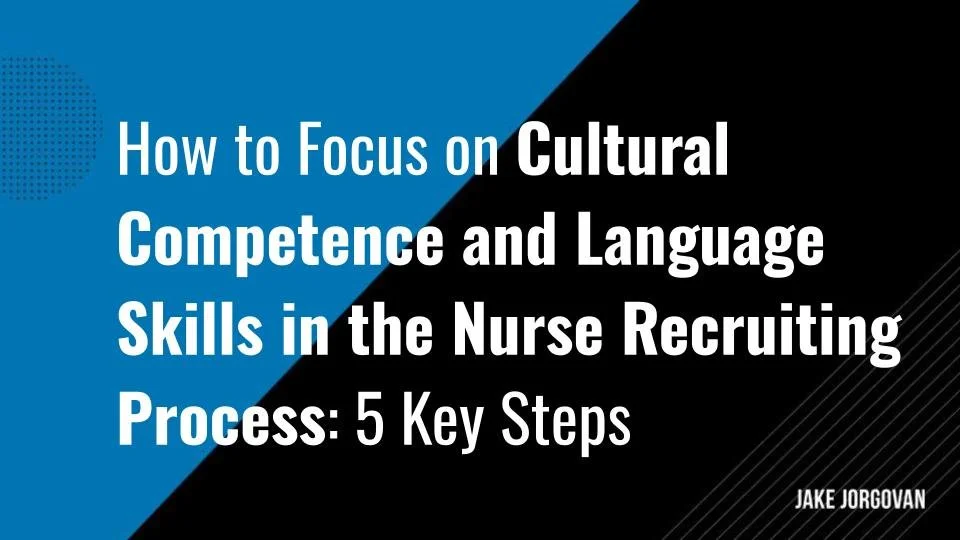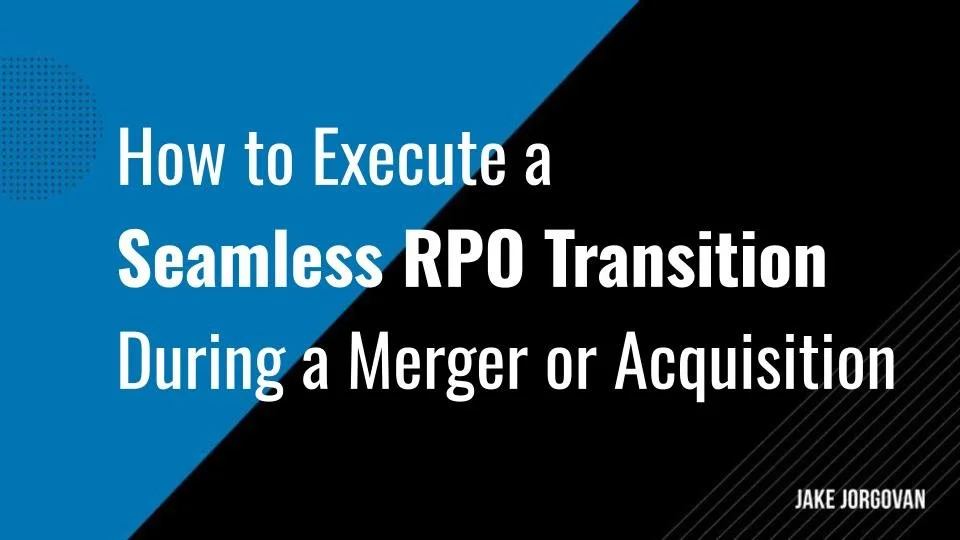How to Execute a Seamless RPO Transition During a Merger or Acquisition
How to Execute a Seamless RPO Transition During a Merger or Acquisition
Navigating a merger or acquisition is challenging.
Integrating Recruitment Process Outsourcing (RPO) can complicate matters further. A poorly managed RPO transition can disrupt operations and talent acquisition.
How do you ensure a seamless RPO transition during this critical period?
This article provides actionable strategies and essential steps for success
You'll learn how to align stakeholders, manage expectations, and ensure continuity.
Let's dive into the key elements for a smooth RPO transition.
5 Steps for Executing a RPO Transition During a Merger or Acquisition
1) Align and Integrate Recruitment Strategies with Organizational Goals
To achieve a seamless RPO transition during a merger or acquisition, it’s essential to align recruitment strategies with overarching organizational goals. This alignment ensures that the recruitment process directly contributes to the company's success. It also minimizes disruptions that can arise during significant organizational changes. Here's how to align and integrate recruitment strategies with organizational goals:
Assess Current Strategies: Conduct a thorough review of existing recruitment strategies and identify areas that need alignment with the new organizational goals. Understand the strengths and weaknesses of the current system to ensure a smooth transition.
Define Organizational Goals: Clearly articulate the short-term and long-term goals of the newly merged or acquired entity. This includes understanding the company's mission, vision, and strategic objectives.
Map Recruitment Needs: Identify the talent needs that will help achieve these goals. This involves understanding the specific roles, skills, and competencies required to drive the organization forward.
Collaborate with Stakeholders: Engage with key stakeholders, including HR, department heads, and senior management, to ensure everyone is on the same page. Collaboration helps in aligning recruitment strategies with business objectives.
Develop a Unified Recruitment Plan: Create a comprehensive recruitment plan that integrates the best practices from both companies. This plan should outline the recruitment process, timelines, and key performance indicators (KPIs).
Implement Technology Solutions: Use advanced recruitment technologies to streamline processes and improve efficiency. These tools can help in managing candidate pipelines, tracking progress, and ensuring data integrity.
Monitor and Adjust: Continuously monitor the recruitment process and make necessary adjustments to stay aligned with organizational goals. Regular feedback loops and performance reviews are crucial for maintaining alignment.
Insider Tip:
We advise setting up a cross-functional team dedicated to overseeing the RPO transition. This team should include members from HR, IT, and key business units to ensure all aspects of the transition are covered and aligned with organizational goals.
2) Establish Clear Communication Channels and Protocols
Communication is the backbone of a successful RPO transition during a merger or acquisition. It ensures that everyone involved is aware of their roles, responsibilities, and the overall process. Without clear communication, misunderstandings and inefficiencies can derail the transition. To establish clear communication channels and protocols, follow these steps:
Identify Key Stakeholders: Determine who needs to be involved in the communication loop. This includes HR teams, management, RPO providers, and relevant department heads.
Define Communication Objectives: Clearly outline what needs to be communicated, to whom, and why. Ensure each message has a purpose, whether it's an update, instruction, or feedback.
Choose Appropriate Channels: Select the best communication channels for different types of messages. Use email for formal updates, instant messaging for quick clarifications, and meetings for detailed discussions.
Set Up a Communication Schedule: Establish a regular schedule for updates and check-ins. This could be weekly meetings, bi-weekly reports, or monthly reviews to keep everyone informed and aligned.
Develop Standard Operating Procedures (SOPs): Create SOPs for common communication scenarios. This helps standardize the process and ensures consistency in messaging.
Utilize Collaboration Tools: Implement collaboration tools like project management software, shared document platforms, and communication apps to streamline interactions and record communications.
Encourage Feedback: Create a feedback mechanism where team members can voice concerns, ask questions, and provide suggestions. This ensures that communication remains two-way and dynamic.
Insider Tip:
Using a centralized communication dashboard improves the efficiency of your communication strategy. This dashboard should integrate all communication channels and provide real-time updates to effortlessly keep everyone in the loop.
3) Ensure Robust Data Management and Transfer Processes
A robust data management and transfer process is vital during an RPO transition in a merger or acquisition. It ensures that critical information is accurately transferred, secure, and accessible to those who need it. Effective data handling minimizes disruptions and supports seamless integration. Here’s a step-by-step approach to ensure robust data management and transfer:
Conduct a Data Audit: Begin with a comprehensive audit of all existing recruitment data. Identify what data exists, where it is stored, and who has access to it.
Classify Data: Categorize the data based on its importance and sensitivity. This helps prioritize what needs immediate attention and secure handling.
Develop a Data Transfer Plan: Create a detailed plan outlining how data will be transferred. Include timelines, responsible parties, and methods of transfer to ensure clarity and accountability.
Select Appropriate Tools: Use reliable data transfer tools and software that support secure and efficient migration. Ensure these tools comply with relevant data protection regulations.
Implement Data Security Measures: Protect data during the transfer process with encryption and secure transfer protocols. Ensure only authorized personnel have access to sensitive information.
Validate Data Integrity: After the transfer, verify that the data has been accurately migrated. Check for completeness, accuracy, and consistency to avoid potential issues.
Establish Access Controls: Set up access controls to manage who can view and modify the data. This helps maintain data security and integrity post-transfer.
Create Backup Plans: Establish backup systems to protect against data loss during the transfer process. Update these backups regularly and test their reliability.
Insider Tip:
We recommend setting up a data reconciliation team to enhance the accuracy and reliability of the data transfer process. This team should focus on verifying data integrity at each stage of the transfer and resolving any discrepancies immediately.
4) Provide Comprehensive Training for Involved Personnel
Effective training is essential to ensure that all involved personnel understand their roles and responsibilities during an RPO transition. Proper training minimizes errors and enhances efficiency. It also creates a sense of confidence and readiness among team members. Here’s how to do it:
Assess Training Needs: Start by identifying your team members' specific skills and knowledge gaps. Then, conduct surveys or interviews to understand their current proficiency levels and training needs.
Develop a Training Plan: Create a structured plan that outlines the training objectives, schedule, and materials. Ensure the plan aligns with the overall goals of the RPO transition.
Select Training Methods: Choose the most effective training methods for your team. This could include workshops, online courses, hands-on sessions, and mentoring programs. Tailor these methods to suit different learning styles.
Prepare Training Materials: Develop high-quality training materials, including manuals, presentations, and videos. Make these resources easily accessible to all participants.
Schedule Training Sessions: Plan and schedule training sessions at convenient times for your team. Ensure the schedule allows for flexibility and sufficient time to cover all necessary topics.
Conduct Training: Implement the training sessions according to your plan. Use interactive methods to engage participants and encourage active learning. Address any questions or concerns promptly.
Evaluate Training Effectiveness: After the training, evaluate its effectiveness through assessments, feedback surveys, and performance reviews. Identify areas for improvement and adjust future training sessions accordingly.
Provide Ongoing Support: Offer continuous support and resources to your team even after the initial training. This could include follow-up sessions, additional learning materials, and access to expert advice.
Insider Tip:
From our perspective, integrating a mentorship program significantly enhances the effectiveness of your training. Pairing less experienced team members with seasoned mentors ensures continuous learning and builds a more resilient and knowledgeable team.
5) Implement Continuous Monitoring and Feedback Mechanisms
Implementing continuous monitoring and feedback mechanisms is crucial for a successful RPO transition during a merger or acquisition. This approach ensures that the process remains on track and any issues are promptly addressed. It also helps maintain alignment with organizational goals and facilitates ongoing improvements. Here's how to implement continuous monitoring and feedback mechanisms:
Establish Clear Metrics: Define key performance indicators (KPIs) that will help you measure the success of the RPO transition. These metrics should align with your organizational goals and provide a clear picture of progress.
Set Up Real-Time Monitoring Systems: Implement tools and software that allow for real-time tracking of recruitment activities. This could include dashboards, analytics tools, and reporting systems to provide instant insights.
Create a Feedback Loop: Develop a structured feedback loop where team members can regularly share their observations and suggestions. This should include both formal and informal channels for comprehensive input.
Conduct Regular Check-Ins: Schedule frequent check-in meetings with key stakeholders to review progress, discuss challenges, and adjust strategies as needed. These meetings should be concise and focused on actionable items.
Analyze Data Continuously: Regularly analyze the data collected through your monitoring systems. Look for trends, patterns, and areas that need improvement to make informed decisions.
Adjust Strategies Promptly: Use the insights gained from your monitoring and feedback to make necessary adjustments quickly. This proactive approach helps address issues before they escalate.
Document Learnings and Best Practices: Keep a record of what works and what doesn’t. Documenting these insights helps in refining your processes and serves as a valuable resource for future transitions.
Insider Tip:
We suggest integrating predictive analytics, which significantly enhances your monitoring efforts. This allows you to anticipate potential challenges and make data-driven decisions to optimize the RPO transition process. Implementing such advanced tools can provide a strategic advantage and ensure a smoother transition.
Handle a RPO Transition with Confidence
Successfully transitioning RPO during a merger or acquisition is a critical task. It requires meticulous planning and execution.
Remember, the stakes are high. A seamless RPO transition can make or break your talent strategy.
Approach this challenge with confidence and clarity. The right strategy can transform potential chaos into a streamlined process.






























